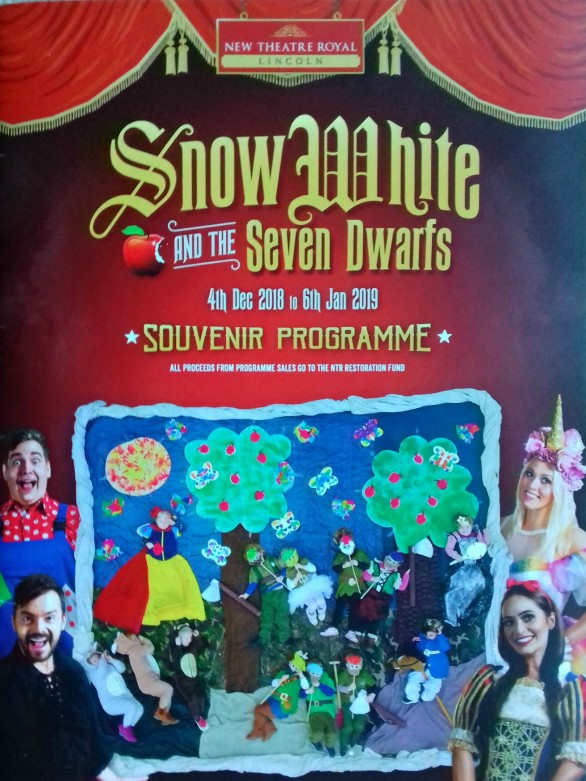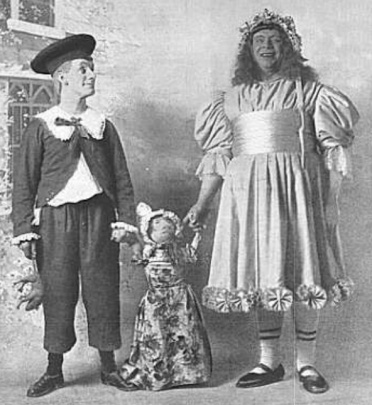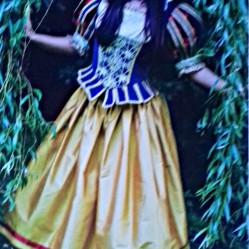
One of the Christmas traditions we still hold on to in the UK is that of the yearly pantomime – or ‘panto’, as it is often called. Last year, we decided to make our first visit to the pantomime in many years, and headed into Lincoln to see Aladdin at the New Theatre Royal.

Having enjoyed it so much, we decided to see if this year’s production, Snow White and the Seven Dwarfs, was as much fun. We weren’t disappointed. Unfortunately, as last year, we weren’t allowed to take any photos once the production had started, but we were told it would be okay to take photos from around the theatre once all the spectators had left. This photo of the stage screen (for want of the correct name) was taken before the show started, and because it doesn’t show any people, I decided it should be okay:
These are a few more photos from around the theatre and foyer:
The New Theatre Royal is a very special place to the people of Lincoln. The Victorian theatre was built in 1893 on the site of a previous theatre built in 1806 which had been destroyed by fire. (The old, 1806 theatre was, in turn, a rebuild of an even older Lincoln theatre built in 1764 – though not on the same site.) The 1893 theatre was falling rapidly into a state of disrepair when the current owners bought it in 2016. After extensive refurbishment and modernisation, this Grade II listed building now looks fabulous. Snow White is the third pantomime produced here since the theatre was restored – the interior design created to resemble the 1893 interior as closely as possible. We didn’t take any photos of the outside, but I found this one on Wikipedia:

We were also told we could take photos from the brochure, so here are three of the cast – a mix of professional actors and comedians, resident stars and local groups.
So, what exactly is a pantomime, and what can we expect when we go to see one?
The actual word pantomime is formed from two words: panto+mime, which means ‘all kinds’ of ‘mime’. It is a type of musical comedy designed for family entertainment. In many countries outside of Britain, pantomime usually refers to mime alone, whereas here it includes songs, bawdy jokes, slapstick, topical humour and dancing, all wrapped around the telling of a story, loosely based on a well-known fable, fairy story or folk tale. Some of the most popular stories include Cinderella, Aladdin, Sleeping Beauty, Dick Whittington, Jack and the Beanstalk, Snow White and the Seven Dwarfs, Babes in the Wood and Peter Pan. They are performed over the Christmas and New Year season in many towns and cities across the UK, as well as a few other English speaking countries and France. Some of the larger, city theatres employ professional actors, but there are many pantomimes produced by smaller theatres and amateur dramatic societies.
Pantomime has a long history in Western culture, dating back to the classical theatre. It is generally accepted that British pantomime stems from the masques of Tudor and Stuart times. In the 14th century, masques were performed in the large houses of the rich and were either spoken dramas or musical mime. The timing of the British pantomime at Christmas – with the principal boy played by a girl and the Dame by a man – may have originated in the Feast of Fools in Tudor times. This was presided over by the ‘Lord of Misrule’ and involved much drinking and rowdy merrymaking.

The idea of the selection of the Lord of Misrule himself is thought to have originated in the days of mighty Rome, when masters allowed servants to be in charge for a while during the mid-winter festival of Saturnalia. The result? Chaos reigned.
There is so much more to the history of pantomime than I have outlined here – from the days of Roman pantomime at Saturnalia to the origins of a 17th century French comic genre called the Harlequinade. The latter is the part of a pantomime in which the characters of the Harlequin and Clown play the main parts. Until the 19th century, the harlequinade was an important part of British pantomime. For anyone interested, there are many online sites to delve into.

Pantomime contains certain key elements that spectators expect to see in every performance. In addition to a strong story line, slapstick (custard pies, silly costumes etc.) and music and dance, a few of those elements are:
-
-
-
- Audience participation. This usually includes the audience booing the villain every time he/she appears, shouting out ‘He’s behind you!’ when a wolf or villain arrives on stage and taking part in the two-way argument: ‘Oh yes he is!’ . . . ‘Oh no it isn’t!’
- Goodies and baddies – and the villain is always defeated by the end of the show. Baddies include characters like Captain Hook in Peter Pan and the Wicked Queen in Snow White. The goodies all live ‘happily ever after’.
- A group of juveniles, generally as singers and dancers, but not always. It the version of Snow White that we saw, youngsters played the seven dwarfs, although there were a few older ‘teenagers’ amongst the dancers.
- Comical fights and chases, during which the audience warning shouts of ‘He’s behind you’ come into play.
- Role reversal/gender-crossing actors – men dressed as women and women as men. Examples of men dressed as women are Widow Twankey in Aladdin , and the Ugly Sisters in Cinderella. Also in Cinderella we have a woman playing a male called ‘Buttons’.
- A key, gender-crossing character in every pantomime is the ‘Dame’, a man outrageously dressed as a woman and whose performance is exaggerated and extravagant. Widow Twankey in Aladdin and and Nurse Flossy in Snow White are examples, as is this ‘large’ female from an 1887 production of Babes in the Wood. I’ll make no comment regarding the appearance of the ‘child’ other than, ‘Oink, oink’!

Dan Leno and Herbert Campbell in costume for the 1897 pantomime, The babes in the Wood at the Theatre Royal, Drury Lane. Source: The Sketch, Illustrated London News, 19 January 1898. Public Domain. - The Dame is generally played by an oldish, unattractive man who interacts with the two principal characters and is instrumental to the plot and the happy ending. It is thought that role reversal may have also evolved from the ‘Feast of Fools’ of Tudor times, in which the Lord of Misrule created an unruly, raucous event involving role reversal, a lot of drinking and noisy festivities. As I mentioned above, the whole idea probably originated in the Roman festival of Saturnalia.
-
-
The New Theatre Royal continues to be a popular venue in Lincoln. There are shows during the year, and in 2019 they kick off with The Variety Show on January 26 and The Wizard of Oz over the Easter period (April 13-23). And next Christmas, we can look forward to the pantomime, Robin Hood, for which bookings can already be made! Yes, pantomime continues to be a popular as ever in Lincoln – and by no means is the New Theatre Royal the only place to see one – but it is nice and comfortable, and full of old world charm…












Lovely article about a very British phenomenon. I went once to the theatre in Norwich to see one. (Sheila Ferguson of the Three Degrees starring in it). Halfway there was a bomb alarm and we all had to leave the building. We were standing in the freezing cold for some 40 minutes and decided to take a taxi home. We had to pass the theatre and saw the audience walking in again. We couldn’t be bothered anymore, so we went and drank our sorrow in our local pub.
Hi castlecat579! Thank you for that great comment. It certainly gave me a laugh. The image of people standing in the pouring rain isn’t really anything to laugh about – nor is a bomb alert! But the image of you skulking off to drown your sorrows in the local pub is so funny! You’ll have to make the effort to get to a pantomime another year. Unfortunately, you’ve missed your chance of seeing Sheila Ferguson. Lol We had Barney Harwood from Blue Peter as one of the professionals in Snow White. The children in the audience loved that!
A wonderful, and fascinating, summary of one of our festive institutions, Millie. Wishing a very Merry Christmas to you and your family, and everything good in the year ahead. Best regards, Mike.
Thanks, Mike. I think most of us enjoy a bit of silliness from time to time. Have a lovely Christmas with your family, too. By the way, have you published your book yet? That should be a really informative read.
Thank you for sharing this with us, Millie. It’s the perfect holiday post. Merry Christmas to you and your family!
Thank you, Jill. I’m actually feeling quite festive, especially now it’s Christmas Eve. Pantomime visits, school Nativity plays and carol services all help to make the season particularly special. I hope you have a wonderful Christmas with your family.
I’m glad you enjoyed the panto! Happy Christmas to you and the family 🙂
The panto was fun, Ali. It was brilliant to see the audience enjoying themselves – and not just the children, Have a very happy Christmas and a great 2019. 😀
Pantomimes are great fun. Thanks for this merry post. Wishing you very Happy Holidays from Australia.
Merry Christmas, Peggy. I hope your holiday has been a great one so far. I know you have pantomimes in Australia and I can only agree that they’re a lot of fun. Happy New Year to you and yours.
I’ve never been to a pantomime. It sounds exciting and much fun to interact with the actors. Interesting information, thanks for your description. I hope you have a lovely Christmas with your family and friends.
We’ve only been to two in recent years, but have really enjoyed the fun of them. Now we’re quite ‘hooked’. I hope your Christmas is a wonderful one, too! It’s always over so quickly.
Hello Millie! Great to read your most interesting post . I wasn’t familiar with the British pantomime. It is very similar to the Italian and French pantomime. Merry Christmas! 🎄
Hello, Irina! I hope you’re enjoying a lovely Christmas in the sunshine. We still have Boxing Day to look forward to and then, of course, New Year’s Eve, Pantomimes are a great part of the build up to Christmas, although we’ve missed out on many over the years. I’.m looking forward to next year’s already. 😀
Another great post, Millie. Delighted you had fun in the Theatre Royal last year. I watched Aladdin a couple of weeks ago, and I have actually seen all of the mentioned. Just love myself a good panto before Christmas :).
Hope you have a Merry Christmas, and a wondrous New Year!
Thank you, Inese. I know pantomimes are as popular in Ireland as they are here, so I’m not surprised to hear you love them, too! They are a lot of fun, and the audience participation is one of the best things about them. Pantomimes are a wonderful part of the build up to Christmas and a great night out for families. I hope you have a lovely Boxing Day tomorrow and a wonderful 2019! 😀
Thank you Millie! Yes, I do love the audience participation part, and also including of the local news and names 🙂 It is hilarious 🙂
I always learn so much from you–thank you! Wishing you and yours a happy Christmas and a merry Yule!
Thank you so much for that, Susan. I’m happy to know you enjoyed my post! I wish you and your family a very Happy Christmas and a wonderful 2019. 😀
Hey Millie, just came over to your blog to check how have you been. BTW lovely post here…!